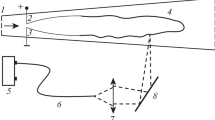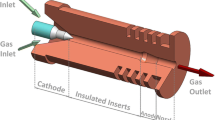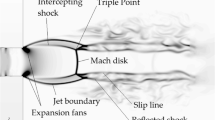Abstract
Computed results are presented describing the temperature and concentration fields obtained when an argon plasma jet is being discharged into ambient air. A previously published mathematical model for turbulent plasma plumes is used for the calculations. These predictions are compared with recent), published experimental measurements by Brossa and Pfender, performed with an enthalpy probe. The theoretical predictions appear to agree reasonably well with the measurements of both the temperature and concentration profiles, with a maximum deviation in the 10–20% range.
Similar content being viewed by others
Abbreviations
- A max :
-
maximum temperature or velocity in the torch exit profile
- C 1 C 2 C D :
-
constants inK-ε model
- h :
-
enthalpy
- I :
-
torch current
- K :
-
turbulent kinetic energy per unit mass
- m :
-
mass concentration of plasma p pressure
- Q :
-
How rate of argon through the torch
- r :
-
radial coordinate
- r n :
-
nozzle radius (inside)
- S θ :
-
source term for dependent variable θ
References
C. P. Donaldson and K. E. Gray,AIAA J. 4, 2017 (1966).
I. P. Incropera and G. Leppert,Int. J. Heat Mass Transfer 10, 1861 (1967).
J. F. Schaeffer,AIAA J 16, 1068 (1978).
S. M. Correa, 6th Int. Symp. on Plasma Chemistry, Montreal, July 24–28, Vol. 1, (1983).
J. McKelliget, J. Szekely, M. Vardelle, and P. Fauchais,Plasma Chem. Plasma Process.2, 317 (1982).
A. H. Dilawari and J. Szekely,Plasma Chem. Plasma Process.7, 317 (1987).
A. H. Dilawari and J. Szekely,Int. J. Heat Mass Transfer 30, 2357 (1987).
A. H. Dilawari and J. Szekely,Mater. Res. Symp. Proc. 98, 3 (1987).
A. H. Dilawari, J. Szekely, J. Batdorf, and C. B. Shaw,Plasma Chem. Plasma Process.10, 323 (1990).
A. H. Dilawari, J. Szekely, J. F. Coudert, and P. Fauchais,Int. J. Heat Mass Transfer 32, No. 1, 35 (1989).
Y. P. Chyou and E. Pfender,Plasma Chem. Plasma Process.9, 291 (1989).
M. Brossa and E. Pfender,Plasma Chem. Plasma Process.8, 75 (1988).
B. E. Launder and D. B. Spalding,Mathematical Models of Turbulence, Academic Press, London (1972).
W. M. Pun and D. B. Spalding, Rep. No. HTS/76/2, Heat Transfer Section, Imperial College, London (1976).
J. C. Morris, G. R. Bach, and J. M. Yos, Rep. No. ARL-64–180, Aerospace Research Laboratories (1964).
C. H. Liu, Ph.D. Thesis, Department of Mechanical Engineering, Univ. of Minnesota, Minneapolis, Minnesota (1977).
J. M. Yos, Technical Memorandum RAD-TM-63–7, Research and Advanced Development Division, AVCO Corporation, Wilmington, Massachusetts (1983).
D. C. Evans and R. S. Tankin,Phys. Fluids 10, 1137 (1967).
C. R. Wilke,J. Chem. Phys. 18, 517–519 (1950).
P. Fauchais, M. Boulos, and E. Pfender, Physical and Thermodynamic Properties of Thermal Plasmas, in Plasma Technology, in Metallurgical Processing, Iron and Steel Society, Warrendale, Pennsylvania (1987), pp. 11–26.
Author information
Authors and Affiliations
Rights and permissions
About this article
Cite this article
Dilawari, A.H., Szekely, J. & Westhoff, R. A comparison of experimental measurements and theoretical predictions regarding the behavior of a turbulent argon plasma jet discharging into air. Plasma Chem Plasma Process 10, 501–513 (1990). https://doi.org/10.1007/BF01447261
Received:
Revised:
Issue Date:
DOI: https://doi.org/10.1007/BF01447261




